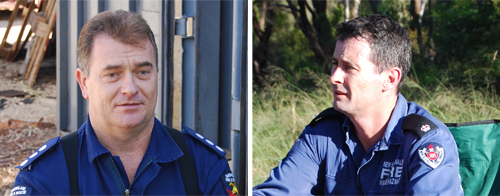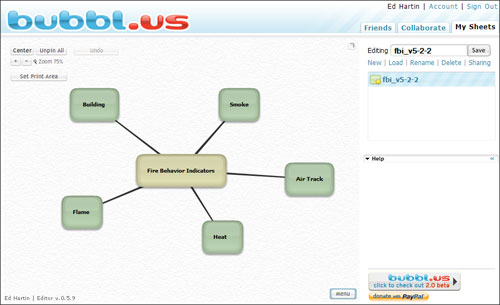Reading the Fire:
How to Improve Your Skills
Monday, June 8th, 2009
Congratulations!
I would like to offer my congratulations to my two friends and colleagues Inspector John McDonough, ASFM of the New South Wales Fire Brigades and Acting Inspector Shan Raffel, CIFireE, EngTech, ASFM of Queensland Fire Rescue on receiving the Australian Fire Service Medal (AFSM) for distinguished service to their nation’s fire service. This is the second accolade for Shan in the last several months as he was recognized as a Companion of the Institution of Fire Engineers (IFE) for his work as national president and his tireless work for IFE Australia. Outstanding work gentlemen, honors well deserved!
Figure 1 ASFM Recpients Shan Raffel (left) and John McDonough (right)

B-SAHF! Master Your Craft
In Reading the Fire: B-SAHF, I introduced the B-SAHF (Building, Smoke, Air Track, Heat, and Flame) conceptual framework for reading the fire and have subsequently provided a series of video clips and photos to provide an opportunity to exercise your skill in reading the fire. While looking at video, photos (and actual incidents) may help build your knowledge and skill, different types of practice and knowledge building can also further your professional development.
Concept Maps
A concept map is a graphic tool for representing knowledge (Novak & Caņas, 2008). The map illustrates concepts and their relationships to one another (similar to an electrical circuit diagram or road map). Concept maps use a hierarchical form (similar to an organizational chart) with general concepts at the top and details further down. Mind maps are a similar tool often used in brainstorming that use a radial hierarchy with a tree-like hierarchy branching out from the center. I draw on both of these approaches in describing fire behavior indicators. A radial hierarchy is used as the foundation, but other relationships are illustrated and concepts can be interconnected in a variety of different ways.
A key step in improving your ability to read the fire is to think about what you should be looking for. Identifying key indicators and thinking about what they mean can be an important step in developing and improving your knowledge and skill. I find that this is an ongoing process as I continue to add to and refine my fire behavior indicators concept map. This map is not a fireground tool or a checklist of things to look for, but serves as a representation of my understanding and learning. While I am willing to share this map (Ed’s B-SAHF Map v5.2.1), it is more useful for you to build your own, representing your own understanding of these indicators and concepts.
Concept maps can be created using a pencil and paper, Post-It notes and an easel pad or white board, or using a computer with drawing software or a program specifically created for concept mapping. At one point or another, I have used each of these tools and find that they all have advantages and disadvantages. The tools you use are not as important as the mental process of collaborating with others and creating your map.
The Starting Point
Without getting bogged down an a long discussion of the educational and psychological foundations for concept mapping, it is important to understand that development of concept maps supports meaningful rather than rote learning. Rote learning often involves simple memorization. Meaningful learning requires three conditions (Ausubel, 1963).
- Concepts must be clear and presented with common language and examples connected to the learner’s prior knowledge.
- The learner must have relevant prior knowledge. Note that the learner does not require expertise, but needs sufficient knowledge to make sense of the concepts involved.
- Most importantly, the learner must choose to learn in a meaningful way.
Many firefighters struggle with creating mind maps (at first) because much of fire service training focuses on rote learning. However, I find that this challenge can easily be overcome if firefighters recognize the value of exploring the key fire behavior indicators and their relationships to one another.
Developing a concept map starts with a focus question that specifies the problem or issue that the map is intended to help resolve. The fire behavior indicators (FBI) concept map starts with the following focus question:
What building, smoke, air track, heat, and flame indicators
provide clues to current and potential fire behavior?
It is important to remember that a concept map is never finished. After you develop the first draft, it is always necessary to revise the map to increase clarity or add important concepts that you discover as work continues. For example, my FBI Concept Map is on Version 5.2.1, indicating five major revisions and 21 minor revisions or additions over seven years!
Knowledge Soup
The best concept maps are not developed in a vacuum. Collaboration with others can help us identify additional information and provides ideas that we may not have thought of on our own. For example, the current version of my FBI concept map started as my collaboration with Shan Raffel. However, it has evolved to include suggestions from hundreds of CFBT course participants.
Propositions or ideas developed by a group of learners may be thought of as ingredients in a kind of “knowledge soup” (Caņas, Ford, Hayes, Brennan, & Reichherzer, 1995, p. 4). The learners share the ingredients and each cook their own variation on the soup by constructing their own understanding. One way to approach this is to brainstorm key concepts and ideas before beginning the process of organizing the information and drawing the map.
Technology and Information Sharing
We have an advantage today that firefighters in previous generations did not have. Technology provides unparalleled opportunity for collaboration and learning. For example, this blog provides me with an opportunity to communicate and share information with firefighters around the world in a matter of minutes. In addition to my twice weekly blog posts, micro-blogging using the CFBT-US Twitter page provides a simple and easy method to rapidly share information on a daily (and in some cases hourly) basis.
Recently I have been reading a series of blog posts titled 31 Days to Build a Better Blog on Problogger. This stimulated my thinking about different ways to leverage technology to share information within the fire service and more particularly the compartment fire behavior community. Twitter may provide a simple means for collecting the ingredients needed for the knowledge soup necessary to develop and improve our respective fire behavior indicators concept maps.
This process could be started posting a question focused on one element of the FBI Concept map such as: What key building factors that impact on fire behavior can be used as indicators of current and predicted fire behavior? Readers can then respond (Tweet Back) with brief statements (no more than 140 characters) that identify the factors. All readers would then have access to this information when constructing the Building Indicators segment of their FBI Concept Map.
Another challenge is actually drawing the concept map (some of us are more graphically inclined or skilled than others). Bubble.us is a simple and easy to learn tool that provides a way to organize information as a concept map and share the work with others by e-mail, on the web, or embedded in a web page.
Figure 2. Bubbl.us Concept Map

Use of this software is free (you simply visit the bubbl.us web page, sign up and start creating your map. You can share your map with others to read or you can give them permission to edit the map. While I have not used this software extensively, it appears to be extremely easy to use and an excellent tool to simplify the process of drawing concept maps.
Where to from Here?
All very interesting, but how does this help us improve our ability to read the fire? Originally I had thought about using the “31 Days” concept to reading the fire. However, it will likely take a bit longer than that.
My next post will propose that we begin with an examination of building factors that influence fire behavior and which may serve as useful indicators in situational assessment. In the mean time, visit the CFBT-US Twitter page and respond to the question about building factors! Follow me for regular updates (you can also subscribe to an RSS Feed to receive information in a feed reader or via e-mail).
Each month I will move to the next element in the B-SAHF organizing scheme for fire behavior indicators until we have completed the entire FBI concept map. However, feel free to work ahead!

Ed Hartin, MS, EFO, MIFireE, CFO
References
Ausubel, D. (1963). The psychology of meaningful verbal learning. New York: Grune and Stratton.
Caņas,A., Ford, K., Hayes, P., Brennan, J., & Reichherzer,T. (1995) Knowledge construction and sharing in Quorum. Retrieved June 7, 2009 from http://www.ihmc.us/users/acanas/Publications/AIinEd/AIinEd.pdf
Novak. J. & Caņas, A. (2008). The theory underlying concept maps and how to construct and use them. Retrieved June 7, 2009 from http://cmap.ihmc.us/Publications/ResearchPapers/TheoryUnderlyingConceptMaps.pdf


